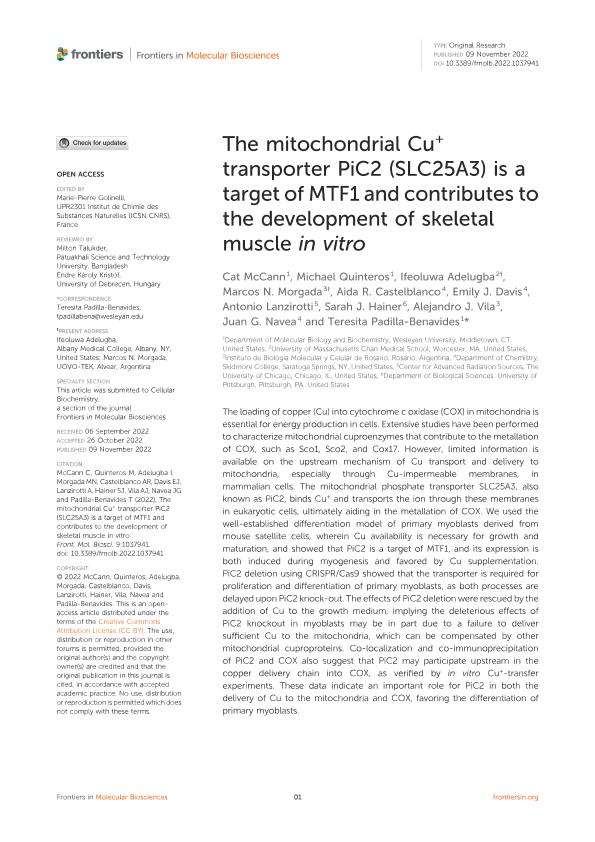Mostrar el registro sencillo del ítem
dc.contributor.author
McCann, Cat
dc.contributor.author
Quinteros, Michael
dc.contributor.author
Adelugba, Ifeoluwa
dc.contributor.author
Morgada, Marcos Nicolás

dc.contributor.author
Castelblanco, Aida R.
dc.contributor.author
Davis, Emily J.
dc.contributor.author
Lanzirotti, Antonio
dc.contributor.author
Hainer, Sarah J.
dc.contributor.author
Vila, Alejandro Jose

dc.contributor.author
Navea, Juan G.
dc.contributor.author
Padilla-Benavides, Teresita
dc.date.available
2023-09-14T14:55:46Z
dc.date.issued
2022-11
dc.identifier.citation
McCann, Cat; Quinteros, Michael; Adelugba, Ifeoluwa; Morgada, Marcos Nicolás; Castelblanco, Aida R.; et al.; The mitochondrial Cu+ transporter PiC2 (SLC25A3) is a target of MTF1 and contributes to the development of skeletal muscle in vitro; Frontiers Media; Frontiers in Molecular Biosciences; 9; 11-2022; 1-17
dc.identifier.uri
http://hdl.handle.net/11336/211530
dc.description.abstract
The loading of copper (Cu) into cytochrome c oxidase (COX) in mitochondria is essential for energy production in cells. Extensive studies have been performed to characterize mitochondrial cuproenzymes that contribute to the metallation of COX, such as Sco1, Sco2, and Cox17. However, limited information is available on the upstream mechanism of Cu transport and delivery to mitochondria, especially through Cu-impermeable membranes, in mammalian cells. The mitochondrial phosphate transporter SLC25A3, also known as PiC2, binds Cu+ and transports the ion through these membranes in eukaryotic cells, ultimately aiding in the metallation of COX. We used the well-established differentiation model of primary myoblasts derived from mouse satellite cells, wherein Cu availability is necessary for growth and maturation, and showed that PiC2 is a target of MTF1, and its expression is both induced during myogenesis and favored by Cu supplementation. PiC2 deletion using CRISPR/Cas9 showed that the transporter is required for proliferation and differentiation of primary myoblasts, as both processes are delayed upon PiC2 knock-out. The effects of PiC2 deletion were rescued by the addition of Cu to the growth medium, implying the deleterious effects of PiC2 knockout in myoblasts may be in part due to a failure to deliver sufficient Cu to the mitochondria, which can be compensated by other mitochondrial cuproproteins. Co-localization and co-immunoprecipitation of PiC2 and COX also suggest that PiC2 may participate upstream in the copper delivery chain into COX, as verified by in vitro Cu+-transfer experiments. These data indicate an important role for PiC2 in both the delivery of Cu to the mitochondria and COX, favoring the differentiation of primary myoblasts.
dc.format
application/pdf
dc.language.iso
eng
dc.publisher
Frontiers Media

dc.rights
info:eu-repo/semantics/openAccess
dc.rights.uri
https://creativecommons.org/licenses/by/2.5/ar/
dc.subject
COPPER TRANSPORT
dc.subject
CYTOCHROME C OXIDASE
dc.subject
MITOCHONDRIA
dc.subject
MTF1
dc.subject
PIC2
dc.subject
SLC25A3
dc.subject.classification
Biofísica

dc.subject.classification
Ciencias Biológicas

dc.subject.classification
CIENCIAS NATURALES Y EXACTAS

dc.title
The mitochondrial Cu+ transporter PiC2 (SLC25A3) is a target of MTF1 and contributes to the development of skeletal muscle in vitro
dc.type
info:eu-repo/semantics/article
dc.type
info:ar-repo/semantics/artículo
dc.type
info:eu-repo/semantics/publishedVersion
dc.date.updated
2023-07-07T20:16:49Z
dc.identifier.eissn
2296-889X
dc.journal.volume
9
dc.journal.pagination
1-17
dc.journal.pais
Suiza

dc.journal.ciudad
Lausana
dc.description.fil
Fil: McCann, Cat. Wesleyan University; Estados Unidos
dc.description.fil
Fil: Quinteros, Michael. Wesleyan University; Estados Unidos
dc.description.fil
Fil: Adelugba, Ifeoluwa. University of Massachussets; Estados Unidos
dc.description.fil
Fil: Morgada, Marcos Nicolás. Consejo Nacional de Investigaciones Científicas y Técnicas. Centro Científico Tecnológico Conicet - Rosario. Instituto de Biología Molecular y Celular de Rosario. Universidad Nacional de Rosario. Facultad de Ciencias Bioquímicas y Farmacéuticas. Instituto de Biología Molecular y Celular de Rosario; Argentina
dc.description.fil
Fil: Castelblanco, Aida R.. Skidmore College; Estados Unidos
dc.description.fil
Fil: Davis, Emily J.. Skidmore College; Estados Unidos
dc.description.fil
Fil: Lanzirotti, Antonio. University of Chicago; Estados Unidos
dc.description.fil
Fil: Hainer, Sarah J.. University of Pittsburgh; Estados Unidos
dc.description.fil
Fil: Vila, Alejandro Jose. Consejo Nacional de Investigaciones Científicas y Técnicas. Centro Científico Tecnológico Conicet - Rosario. Instituto de Biología Molecular y Celular de Rosario. Universidad Nacional de Rosario. Facultad de Ciencias Bioquímicas y Farmacéuticas. Instituto de Biología Molecular y Celular de Rosario; Argentina
dc.description.fil
Fil: Navea, Juan G.. Skidmore College; Estados Unidos
dc.description.fil
Fil: Padilla-Benavides, Teresita. Wesleyan University; Estados Unidos
dc.journal.title
Frontiers in Molecular Biosciences
dc.relation.alternativeid
info:eu-repo/semantics/altIdentifier/url/https://www.frontiersin.org/articles/10.3389/fmolb.2022.1037941/full
dc.relation.alternativeid
info:eu-repo/semantics/altIdentifier/doi/http://dx.doi.org/10.3389/fmolb.2022.1037941
Archivos asociados
